

X- Mega-sutures & Sedimentary Basins
The global result of the geological evolution described, previously, can be summarized by the following condensed tectonic synthesis:
1) Oceans are products of Paleozoic and Mesozoic-Cenozoic ocean spreading and extension.
2) Paleozoic and Ceno-Mesozoic mega-sutures of the world are the compressional contemporaneous equivalent of the ocean spreading.
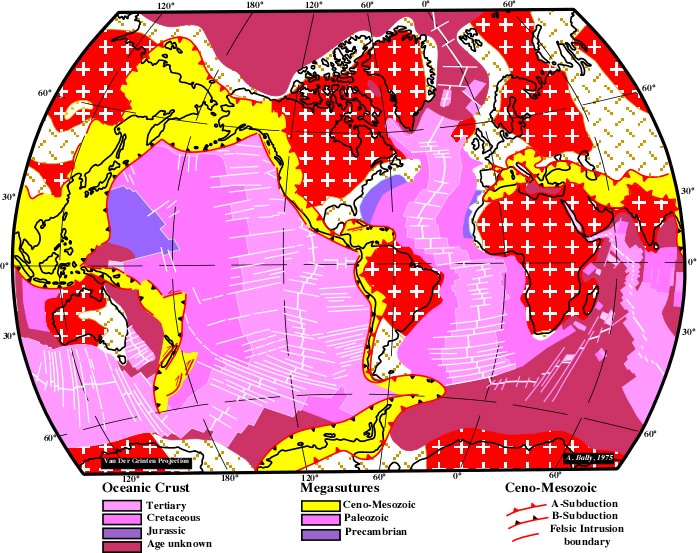
Fig. 53- Ceno-Mesozoic mega-suture, post-Pangea oceanic crust and associated geologic features
3) The combined Paleozoic fold belts which, except for Circum-Pacific areas, represent the Paleozoic mega-sutures now bound on both sides by continental crustal and by A subduction zones. -
Paleozoic “B” subductions can only be surmised, because Paleozoic oceanic crust has not been preserved in its pristine undeformed shape and only minor amounts of Paleozoic oceanic crust occur in form of obducted ophiolites.
Two basic alternatives may be suggested:
(a) the B subduction process has been so effective that most Paleozoic oceanic crust was disposed of, or
(b) Paleozoic geosynclines did not have substantial oceanic areas.
4) The Precambrian fold belts of the world represent several Precambrian mega-sutures. Again, no pristine Precambrian oceanic crust is believed to occur.
A mega-suture can be described using the worldwide Ceno-Mesozoic mobile fold belts as an example. The boundaries of this mega-suture are defined to include all products of Ceno-Mesozoic orogenic and associated igneous activities. Emphasis is laid on the dominant compressional mode of deformation, but we are mindful of the observation that in these belts, extensional deformation and basin formation are widespread. The processes responsible for the extensional deformation are deemed to be subordinate and a consequence of the complex subduction processes.
Mega-sutures show a record of folding, thrust faulting and igneous activity. They are. often, associated with ductile flow of crustal rocks. Intrusive and metamorphic structures are extensive. Mega-sutures, when viewed over time spans in order of 10 M to 100 My, are very mobile realms. It is unwise to tract them as part of rigid plates, when in fact, they are pervasively plastically deformed. Because of the great difficulties in palinspastically reconstructing mega-sutures, it is most hazardous to extrapolate paleomagnetic and paleogeographic control data from onto adjacent, more rigid cratons.
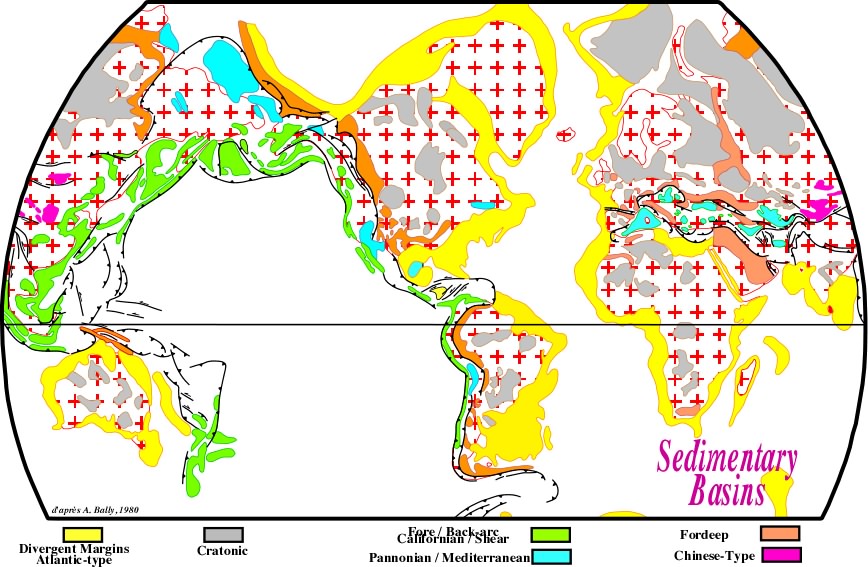
Fig. 54- Classification of sedimentary basins of Bally and Snelson slightly modified.
Using the mega-sutures and, particularly, the Ceno-Mesozoic mega-suture, A. Bally1 proposed, in 1980, a classification of the sedimentary basins in three large families (see figs. 54 & 55):
a) Episutural
Ex: Back-arc, Pannonian, Mediterranean, Fold belts, etc,
b) Perisutural
Forearc, Fore-deep, etc., and
c) Basins not associated with the formation of megasutures
Rift-type , Cratonic and Divergent margin.
This basin classification (figs. 54 & 55) combining realms of subsidence and tectonics regimes, is, in my opinion, the most appropriated for hydrocarbon exploration. It will be used during this short course.
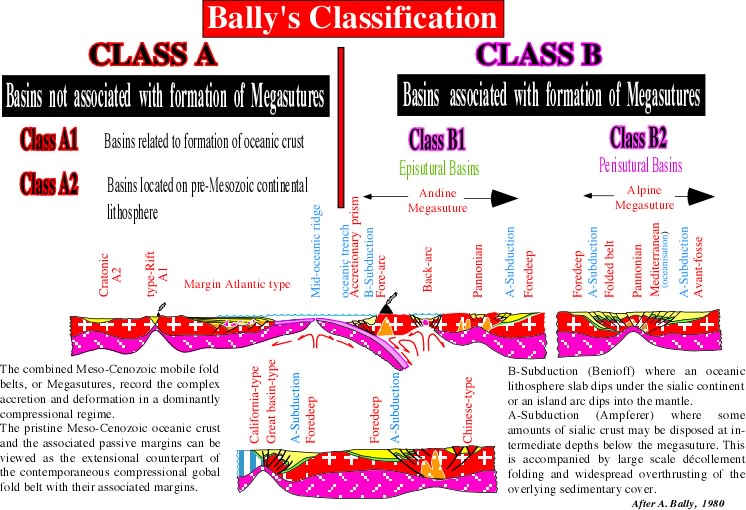
Fig. 55- The basic principles of Bally & Snelson classification of sedimentary basins are schematized illustrated in this figure. This basin classification combining realms of subsidence and tectonic regimes is, in our opinion, the most appropriated for hydrocarbon exploration.
XI- Seismic Interpretation Background
Contrary to popular textbook myths, it is rare for a geoscientist to make very many observations without already having a tentative , or working hypothesis in mind to test. In fact, in seismic interpretation there is a constant feedback among observation and hypotheses. Moreover, some hydrocarbon exploration breakthroughs have resulted from intuitive flashes based upon skimpy evidence1.
Thus, before ending the first part of this short course, I would like to illustrate here below what is often called the mental setting preparation, or the making ready for performing interpretation of seismic data. Actually, first of all, it is strongly recommended to review the geological setting of the basin where the lines were shot. Such a knowledge allows to be acquainted with the major geological events which took place in the basin and to understand their seismic signature. The knowledge of the geological setting of the area under study gives crucial informations to evaluate correctly the majority of hydrocarbon parameters, such as:
- potential source rocks,
- migration time & migration paths,
- potential traps and their age,
- the potential reservoirs and
- the retention.
The understanding of the interconnections between the geological settings and the hydrocarbon parameters, is expressed in Bally's classification where the plate tectonics theory and the genesis of subsidence play a major role.
Thus, it is utterly useful to class, in space and time, the different stacked basins which compose the area of interest and take into account, at least in the begriming of the interpretation, the basic a priori geological hypotheses.
Let's illustrate the preparation for interpretation with two seismic lines taken from classic hydrocarbon basins: Kwanza basin, in Angola, and Saigon basin, in offshore Vietnam.
Offshore Angola:
The tentative geological interpretations of the Angola offshore seismic lines, such as that illustrated on figure 56 requires an a priori knowledge of the geological setting of the Western African sedimentary basins. Otherwise, the interpreters will spend months, even years, to recognize the major geological events of these basins and the associated seismic patterns.
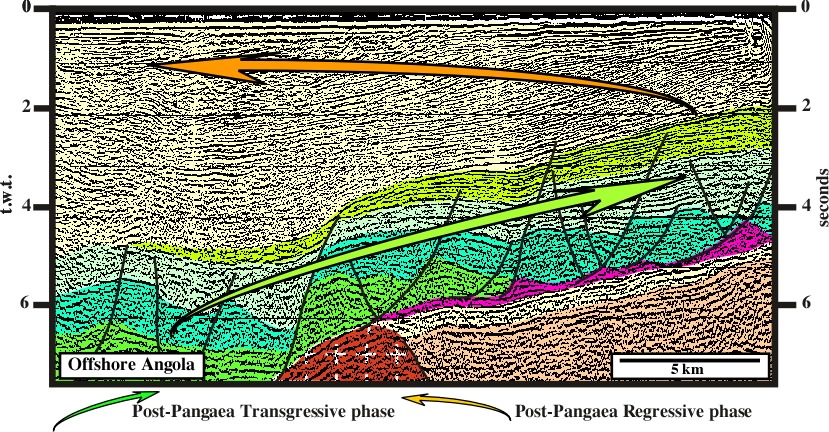
Fig. 56- Seismic line of conventional Angola offshore (Block 2)
Using systems thinking approach the interpreter will progress as follows:
a) The Angola offshore is associated with the break-up of Pangea super-continent. Meso-Cenozoic sediments overlain a lengthened Pangea continental crust, which includes Mesozoic rift-type basins or a Pre-Pangea substratum (Paleozoic or Precambrian).
b) The break-up of Pangea took place in two distinct phases:
(i) rifting phase and (ii) thermal phase.
c) The rifting phase characterizes the stretching of the continental crust (lithosphere above Moho), created rift-type basins (infilled grabens and or half-grabens) bounded by normal faults.
d) The thermal phase is characterized by a thermal subsidence induced by cooling of (i) sub-aerial volcanism (seaward dipping reflectors) and (ii) oceanic volcanism. The thermal subsidence and sedimentary loading created the divergent margin.
e) An angular unconformity is, often, recognized between the rift-type basins and the divergent margin. The age of this unconformity is posterior to the break-up. It is associated with readjustment of lithospheric plates in the onset of oceanization.
f) In distal parts of the lengthened Pangea continental crustal seaward dipping reflectors overlie rift-type basins.
g) The Atlantic-type divergent margin represents the post-Pangea continental encroachment stratigraphic cycle, associated with the Meso-Cenozoic eustatic cycle. It can be subdivided in two sector: (i) Volcanic sector (seaward dipping reflectors, i.e., lava-flows) and (ii) Clastic sector.
h) The divergent margin is composed by a transgressive phase and a regressive phase. The transgressive phase is associated with the 1st order eustatic sea level rise and the regressive phase with the 1st order eustatic sea level fall. The maximum of transgression took place in Cenomanian-Turonian.
i) On the seismic lines, the transgressive phase is characterized by a retrogradational or backstepping geometry, while the regressive phase is characterized by a progradational or forestepping geometry. A major downlap surface underlines the limit between these phases.
k) At the break-up, lava flowed from the spreading centers toward the continent across the distal rift-type basins. Occasionally, lava flows into lakes or epicontinental seas. They frozen abruptly, preserving steep inward dips seismically resemble deltaic foreset beds.
l) When the underlying lithosphere cooled, thermal subsidence lowered the lava-flows an the expansion centers below sea level. Environment became marine, and the spreading center submerged to become an oceanic ridge. Lava no longer flows, laterally, because they frozen, rapidly, under the sea.
m) At an early stage of submergence, marine circulation in shallow, irregular basins was restricted by tectonic and volcanic barriers. That favored formation of local evaporite basins that gradually coalesced as they deepened at about 115 Ma. In this scenario, the opposing Aptian salt basins of the South Atlantic were never contiguous but separated by a spreading center.
n) Aptian evaporites or sandstones mark the onset of the transgressive phase that continued until the rend of Cenomanian- Turonian.
o) Eustatic (absolute) fall of sea level during the Tertiary induced the regressive phase which was enhanced by epeirogenic uplift of continental crust.
With these a priori hypotheses the seismic line can be, easily, interpreted as illustrate in fig. 56. If some of these hypotheses are not corroborated by the interpretation of several lines, the interpreter must advance new hypotheses which in turn must be tested by a new interpretation and so on.
Offshore Vietnam:
a) Vietnam offshore is located within the Meso-Cenozoic Mega-suture.
b) A backarc basin and a non-Atlantic divergent margin form this offshore.
c) Within the backarc, rift-type basins (rifting) and a cratonic or sag basin can be individualized.
d) In the rift-type basins, lacustrine shales rich in organic matter were deposited whenever the rate of subsidence was not balanced by terrigeneous influx.
e) The cratonic or sag basin is characterized by sand-prone stratigraphic interval within good potential reservoirs are found.
f) Normal faulting induced by thinning of the lithosphere are well recognized in both basins (rift-type and cratonic).
g) The extension in the backarc basin resulted of a seaward displacement of the trench, i.e. the trench moved away from the overlying lithospheric plate.
h) The non Atlantic divergent margin is associated with the oceanization of a marginal sea. This oceanization took place in the Late Tertiary. The geometry of sediments composing the non Atlantic-type divergence margin is, globally, progradational. The ratio progradation versus aggradation was a direct function of the rate of sea level rise. When the sea level rose slowly the outbuilding became predominant (upbuilding is very low), (ii) when the rate of sea level rise was rapid the upbuilding became significant and, locally, more important than the progradation.
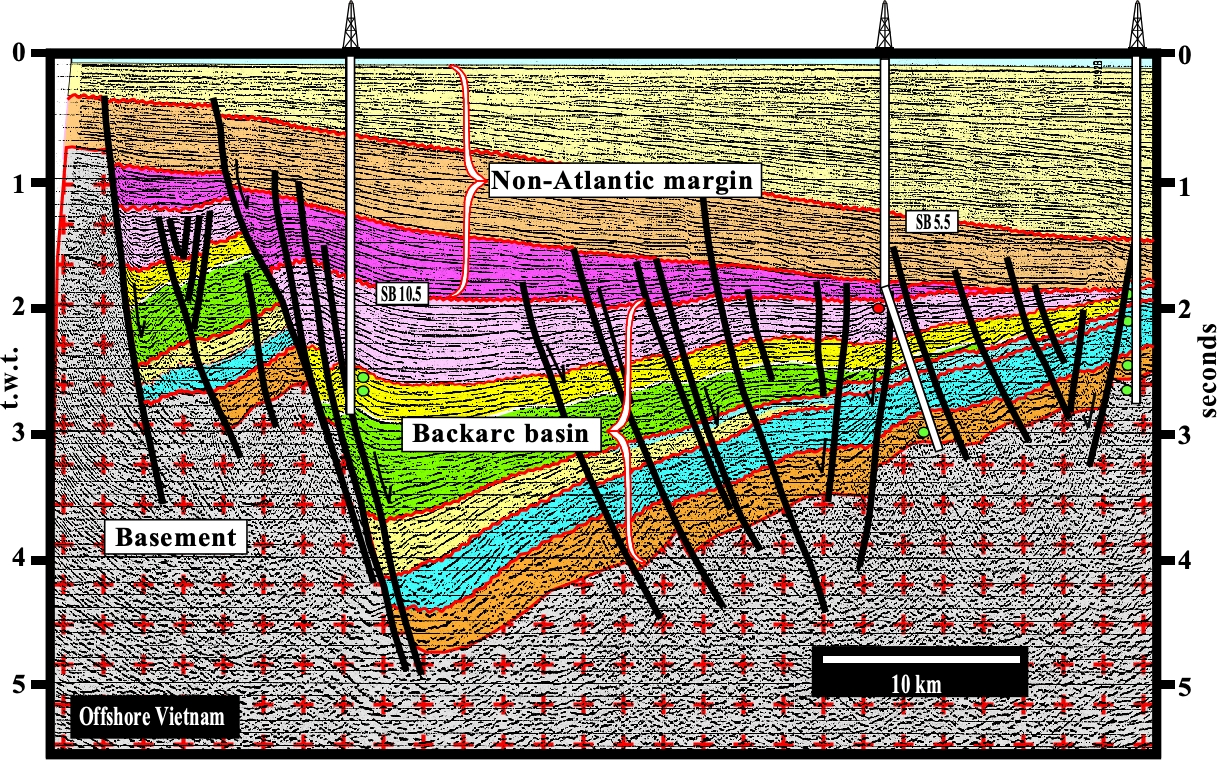
Fig. 57- Seismic line of SE Vietnam offshore located on SW flank of Dai Hung field.
i) The tectonic context of this offshore is compressional. Actually, it is located inside of the Meso-Cenozoic Mega-suture. Thus, in the Late Tertiary the old normal faults, created during the rift-type and sag basins, were reactivated as reverse.
j) The compressional tectonic regime and the reactivation of the previous normal faults, created null points along the fault planes. When the tectonic inversion is not total, in spite of the last fault movement be reverse, normal and reverse fault geometries are found. Normal fault geometries are found below the null points and reverse geometries above the null points.
k) The majority of the traps for hydrocarbons found in this offshore are structural. They are associated with the tectonic inversions.
However, one should not forget that these traps are very young and they are often posterior to the migration time of the hydrocarbons. In fact, the potential source rocks reached maturation during deposition of cratonic sediments.
Take into account all these hypotheses the seismic line illustrated on figure 57 can be, easily be interpreted, where the rift-type basins (rifting phase), the cratonic or sag phase and the non Atlantic-type divergent margins have been picked.
The inverted structures associated with the reactivation of the faults created during the stretching of the lithosphere (rifting phase or rift-type basins) are, clearly, recognized. The traps associated with these structures are, generally, dry. However, as illustrated by the location of the DH#1 discovery well (middle wildcat), the traps filled with hydrocarbons are older, i.e., anterior to the migration time of the hydrocarbons
Notes (see Bibliography):
Mega-sutures & Sedimentary basins
1- see Bally (1985), pp. 17
Interpretation approach
1- see Dott, (1994).

- Abraham, R., 1994.
Chaos, Gaia, Eros: A chaos pioneer uncovers the three greats streams of history
Harper Collins Publishers, New York.
- Ager, D.V.,1984.
The stratigraphic code and what it implies. In Catastrophism and Earth History, The New Uniformitarism. W. A. Berggreen and J.A. Van Couvering. Editors, Princeton University Press.
- Bally, A.W., R. Catalano, J. Oldow.,1985.
Elementi di Tettonica Regionale.
Pitagora Editice, Bologna
- Bak, Per., 1996
How Nature Works: The science of self-organized criticality.
Springer-Verlag, New York, Inc.
- Bates, R.L. and Jackson, J. A., 1980.
Glossary of Geology.
American Geological Institute, Virginia
- Berry, A., 1989, 1993.
The book of Scientific Anedotes
Prometheus Books, New York.
- Bertalanffy, L., 1952.
Problems of Life.
C.A. Watts & Co. Ltd.
- Casti, J.L., 1995
Complexification.
Harper Collins Publishers. Inc. New York.
- Cappra, F., 1982.
The Turning Point.
Simon & Schuster, New York.
- Capra, F., 1996.
The Web of Life: a new understanding of living systems. Anchor books, Doubleday. New York 10036.
- Duval, B. et al. 1993.
Hierarchy of stratigraphic cycles. SEPM Convention, Dijon 1993
- Demaison, G. J. & G.T. Moore, 1980.
Anoxic Environments and Oil Source Bed Genesis.
AAPG, vol. 64, Nº 8, pp. 1179-1209.
-Dott, R.H., Jr. and D. R. Prothero, 1994.
Evolution of the Earth, Mcgraw-Hill, New YorK.
- Embry , A. F.,1993.
Transgressive-regressive (T-R) sequence analysis of the Jurassic succession of the Sverdrupp Basin. Canadian Arctic Archipelago. Can. J. Earth Sci. vol. 30. pp. 301-320.
- Fisher, A. G., 1984.
The two Phanerozoic supercycles. In: Bergren, W.A., Van Couvering, J., (eds). Catastrophs and Earth History. Princeton University Press, Princeton, pp. 129-150.
- Galloway, W.E., and D.K. Hobday, 1983
Terrigeneous Clastic Depositional Systems.
Springer-Verlag, New York.
- Galloway,W.E., 1989a.
Genetic stratigraphy sequences in basin analysis I: Architecture and genesis of flooding-surface bounded depositional units. A.P.P.G. Bull., Vol. 73, pp.125-142.
- Galloway,W.E., 1989b.
Genetic stratigraphy sequences in basin analysis II: Application to Northern Gulf of Mexico Cenozoic basin. A.P.P.G. Bull., Vol. 73, pp.143-154.
- Gamow, G., 1956.
Biographie de la Terre.
Translated by G. Guéron. Librairie Dunod.
- Gould, S.J., 1989
Wonderful life: The Burgess Shale and Nature of History.
New York: W.W. Norton & Cº.
- Greenlee, S.M., Schroeder, F. M., and Vail, P. R., 1988.
Seismic Stratigraphic and Geohistory Analysis of Tertiary Strata from the Continental Shelf off New Jersey; Calculation of Eustatic Fluctuations from Stratigraphic Data; in Sheridan, R.E., and Grow, J.A., eds., The Atlantic Continental Margins, U.S., Geol. Soc. Am., vol. 1-2, p. 437-444.
- Koestler, H.,1967.
The Gost in the Machine.
Hutkinson Publishing Group Ltd.
see also “Holons and Hierarchy Theory” in From Gaia to Selfish Genes. The MIT Press, Cambridge, Massachusetts, London.
- Hallam, A., 1992.
Eduard Suess and European though on Phanerozoic eustasy. In Dott, R. H., Jr., ed., Eustasy: The historical Ups and Downs of a Major Geological Concept; Boulder, Colorado. Geological Society of America Memoir, 180.
- Hamblin, W. K., 1989.
The Earth's Dynamic Systems.
Macmillan Publish Company. New York.
- Hardenbol, J., Vail, P.R., (1987).
The chronology of fluctuating sea level since Triassic: Science, vol. 269, pp. 437-444.
- Hiroki, Y., (1994).
Quaternary crustal movements from facies distribution in the Atsumi and Hamana areas, Central Japan. Sediment. Grol., vol. 93, pp; 223-235.
- Hoyle, F. and Wickramasinghe, C., (1996).
Our Place in the Cosmos. A Phoenix paperback first published in Great Britain by J. M. Dent Ltd in 1993.
-Huxler, J., 1912.
Animal Kingdom.
Cambridge University Press.
-Lovelock, J., 1979.
Gaia.
Oxford University Press, New York.
-Lovelock, J., 1991.
Healing Gaia.
Harmony Books, New York.
- Lovelock, J., (1992).
Mother Earth: Myth oe Science? in “ From Gaia to Selfish Genes” (Selected Writtings in the Life Science).
The MIT Press. Cambridge, Massachusetts. London, England
- Macdougal, J. D., 1996.
A Short History of Planet Earth.
John Wiley & Sons, Inc.
- Marco Polo Software, 1991
PHIL TM Manual. Level 1.5. A basin fill simulation program for Macintosh. Marco Polo Software, Inc. 2307 Tangley Rd. Houston, Texas 7705. USA.1
- Miall, A. D., 1997.
The Geology of Stratigraphic Sequences.
Spriner-Verlag. Berlin.
- Mörner, N., 1976.
Eustasy and geoid change.
Journal of Geology, Vol. 84, pp. 123-151.
-Mörner, N.,1984.
Eustasy, Geoid Changes and Multiple Geophysical Interaction. In: Bergren, W.A., Van Couvering, J., (eds). Catastrophs and Earth History. Princeton University Press, Princeton, pp. 395-413.
- Naomi, O., Shrader-Frechette, K., Kenneth, B., (1994).
Verification, Validation, and Confirmation of Numerical Models in the Earth Sciences. Science. Vol. 263, pp. 641-644.
- Mutti, E., G. Davoli, R. Tinterri and C. Zavala, 1996.
The importance of ancient fluvio-deltaic systems dominated by catastrophic flooding in tectonically active basins. Memorie di Scienze Geologiche, vol. 48.
- Nance, D. and al., 1992.
Mountain Belts and the Supercontinent Cycle Scientific American, vol. 266, nº4, pp. 84-91.
- Naomi, O., Shrader-Frechette, K., Kenneth, B., (1994).
Verification, Validation, and Confirmation of Numerical Models in the Earth Sciences. Science. Vol. 263, pp. 641-644.
- Officer, C. and J. Page, 1993
Tales of the Earth, Paroxysms and Perturbations of the Blue Planet. Oxford University Press.
- Paleomap Resource Pool, 1996
- Peltier, W. R. , 1980.
Gravitationally self constant sea level variations on a deglaciating Viscoelastic Earth., Glacial Isostasy.
- Pitmann, W. C. III, 1978.
Relationship between Eustacy and Stratigraphic Sequence in Continental Margins. Geol. Soc. Am. Bull., vol. 89, pp. 1389-1403.
- Popper, K., 1984.
La logique de la découverte scientifique.
Payot, Paris. (Copyright, Karl Raimund, 1959, 1968).
- Popper, K., 1981.
La quête inachevée.
Calman-Lévy, France.
- Prygogine, I., 1967.
Dissipative Structures in Chemical Systems.
Ed. Stig Claesson- Fast Reactions and primary processes in chemical kinetics.
Interscience, New York.
- Prygogine, I., 1980.
From Being to Becoming.
Freeman, San Francisco.
- Roberts, R. M., 1988.
Serendipity: Accidental Discoveries in Science.
John Wiley & Sons, New York
- Roszak, T., 1994
The Cult of Information
U.C. Press, Berkeley, California
- Sadler, P.M., 1981.
Sediment accumulation rates and the completeness of stratigraphic sections.
Journal of geology, vol.89, pp. 569- 684.
- Sadler, P.M. &Strauss, D.J., 1990.
Estimation of the completeness of stratigraphical sections using empirical data and theoretical models.
Journal of the Geological Society, London, vol. 147, PP. 1990.
- Sclater, J.G. and J. Francheteau, 1970.
The implications of terrestrial heatflow observations on current tectonic and geochemical models of the crust and upper mantle of the earth.
Roy. Astr. Soc. Geophys. Jour., vol. 20, pp. 509-542.
- Sloss, L. L., 1963
Sequences in the cratonic interior of North America
Geol. Soc. Am. Bull. vol. 74, PP 93-113
- Soukhotine, A., 1983.
Les paradoxes de la science.
Editions Mir, Moscou.
- Stantley, S. M., 1992.
Exploring Earth and Life through Time.
W. H. Freeman and Company. New York.
-Suess, E., 1888.
Das Antlitz der Erde.
Tempsky-Freytag. Vol. 2. Prague, Vienna, Leipzig.
-1906, The Face of the earth.
Translated by Solas, W. J., Oxford, Clarendon.
- 1918, La face de la Terre.
Translated by E. Margerie. Paris, Colin, partie 4.
- Turcotte, D.L., 1992.
Fractals and chaos in Geology and Geophysics.
Cambridge University Press, New York.
- Vail, P.R., R.G. Todd and J.B. Sangree, 1977.
Chronostratigraphic significance of seismic reflections.
Amer. Assoc. Petrol. Geol. Mem., vol. 16, pp. 99-116.
- Vail, P.R., R.M. Mitchum, Jr and S. Thompson III, 1977.
Global cycles of relative changes in sea level.
Amer. Assoc. Petrol. Geol. Mem., vol. 26, pp. 83-98.
- Vail, P.R., Bowman, S., and Sangree J. B., 1989.
The Basics of Sequence Stratigraphy for seismic, well and outcrop data.
Rice University. Department of geology and Geophysics.
Houston, Texas 77251.
- Vail, P.R., Audemard, F., Bowman S.A., Eisner, P., Peres-Cruz, C., 1991.
The stratigraphic signatures of tectonics, eustasy and sedimentology- an overview.
In: Einsele, G., Ricken, W., Seilachher, A. (eds). Cycles and events in stratigraphy.
Springer-Verlag, Berlin, Heildelberg, New York, pp. 617-659.
- Wynn, C. M. and Wiggins, A.W., 1997.
The Five Biggest Ideas in Science.
John Wiley & Sons, Inc., New York.
- Wilson, J.T., 1965.
A new class of faults and their bearing on continental drift.
Nature, vol. 207, pp. 343-347.
Send E-mails to carloscramez@gmail.com or to carlos.cramez@bluewin.ch with comments and suggestions to improve these notes.
Copyright © 2001 Ccramez, Switzerland
Last updated: January, 2006, May 2020